|
|
|
| |
|
|
| |
Post Office
and Shop |
|
| |
| |
The
Village Shop and Post Office circa 1912. This
well appointed granite building was originally
built as a bank and bank manager’s house
but, with the decline in fishing, it never functioned
as such.
Standing in front of the shop on the pavement which,
like the road, is unpaved, are the proprietor, Geordie
Forrest, a postman in his pony and trap and villager
Johnny Brand, a veteran of the Crimean War, accompanied
by his dog Princey.
The two-storey granite built 'Leask Cottage' can be
seen in the background. |
| |
|

|
| |
|
|
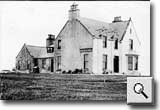 |
| Whiteness
Hotel is closed |
| |
Whiteness
Hotel, viewed from the north circa 1890, stands
on a cliff top location in the High Town area
of Collieston. Built in the latter half of the
19th Century and consisting of some thirty rooms,
it was eventually closed in June 1911 after
many of the locals, particularly the women,
objected to the hotel's well-attended drinking
sessions.
The building was later extended into a shooting
lodge and during World War Two it was requisitioned
by the Army when Forvie was used as a training
ground. By the end of the 20th Century it had
been converted into three individual flats.
The smaller two-storey building seen to the
left of the main building was the original public
bar and servants' quarters.
|
| |
|
|
| |
|
|
| |
Speldings |
|
| |
| |
The
fishwives are standing in the Bog area of Collieston
beside fish drying on racks circa 1910. Gutted
and split the fish were salted, laid in a circle
head out, tail in the centre, and then laid on
racks to dry.
The dried fish were then called speldings. Sold
for one penny each for a large one and one half
penny for a small one, the demand for this famous
Collieston delicacy often exceed the supply and
sometimes speldings had to be posted on to the
customer when a fresh supply was available.
|
|
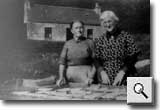 |
| |
|
|
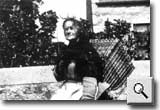 |
| Fishwife |
| |
Rachel
King Walker was the wife of Thomas 'Tooley'
Walker who owned the Peterhead Registered boat
'The Ella Keith'. She is seen here standing
outside Ebenezer Cottage the home of her sister-in-law,
Jessie King, circa 1910. Carrying a creel on
her back, Rachel has a shawl wrapped over her
shoulders to protect them from the heavy weight
of the creel filled with fish.
Wearing a striped skirt, knitted jumper, hessian
apron and stout shoes, Rachel would have had
to walk many miles round the neighbouring countryside
to sell her fish or barter them for fresh produce
from the local farms.
|
|
|
|
| |
|
|
| |
World
War 1 |
|
| |
| |
Three
fishermen from the village who fought in the Great
War of 1914-1918. George Buthlay (seated left)
saw active service in France on the Western Front.
Andrew Mitchell (standing centre) also fought
in France on the Western Front and served in the
Royal Artillery.
Thomas Walker (seated right) served in the Drake
Battalion Royal Naval Division. This special unit
of soldiers in the Royal Navy was sent to attack
ports. Thomas saw active service in the Dardanelles.
All three men returned home safely to Collieston
after their wartime service.
Andrew Mitchell and Thomas Walker lived next door
to one another in the Low Town area of the village
in cottages known at one time as Jubilee Terrace,
the houses having been built in 1887 the year
of Queen Victoria's Golden Jubilee. It is interesting
to note that the cottages are still inhabited
by members of their families. |
| |
|
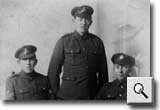 |
| |
|
|
| |
|
|
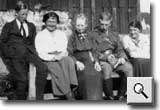 |
An
Army Officer home on leave in 1916. Accompanied
by friends and relatives, the young officer
is enjoying a welcome break far from the hostilities
of World War One. The group of people are
seated on a wooden bench near the foreshore
on a sunny day in summer.
The houses in the distance are situated on
the part of the village known as the Cliff.
The grassy mound behind them, the 'Rivie'
(the promontory which divides Cransdale from
Collieston), is where the 'herdie lad' would
have looked after the dairy cows. .
|
|
|
| |
|
|
| |
|
|
| |
A
gentleman and his two travelling companions in
1915. It must have been a welcome diversion for
the villagers from the troubles of World War One
when the handsome vehicle was driven through Collieston.
To the rear of the travelling party a window of
Leask Cottage is clearly visible. Facing out to
sea, the cottage is situated in Hightown next
to the Village Shop and Post Office.
|
|
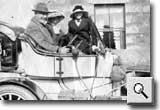 |
| |
|
|
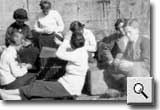 |
A
group of people are sorting sphagnum moss on the
Pier in 1916. During World War One there was an
urgent need for emergency field wound dressings
and sphagnum moss, with a natural chemical substance
that could aid healing, complete with a natural
antiseptic, was much sought after.
Sphagnum moss grew in abundance on the Forvie
Moors, to the south of Collieston. Groups of people
would pick the sphagnum moss and carry it back
to the village where it would be sorted before
being despatched to field hospitals. |
| |
|
|
| |
|
|
| |
Sphagnum
Moss, found in abundance on the moors of the Forvie
National Nature Reserve, was in great demand as
a field dressing during World War One. With a
natural chemical substance that could aid healing,
complete with a natural antiseptic, the common
plant was much sought after.
In addition to its ability to absorb several times
its own weight in water (liquid or blood), Sphagnum
Moss was also light to carry, making it ideal
for carrying as an in-pocket field dressing.
|
| |
|
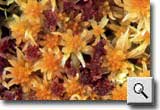 |
| |
|
|
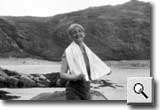 |
Hackley
Bay |
|
| |
A
young woman is bathing at Hackley Bay in 1918.
Accessible only on foot or by boat, Hackley Bay
is situated approximately two kilometres south
of Collieston below the coastal path on Forvie
Moor. Forvie's unique moorland, dune system and
beaches led to it being declared as one of Scotland's
first National Nature Reserves in January 1959.
It is worthwhile making the effort to reach this
spectacular bay. Access is much easier today than
it would have been when the young woman made her
way down the cliffs in 1918 thanks to a new access
route which has been built from the cliff top
in the form of stone pitching and steps.
Hackley Bay, nominated as one of Scotland's most
beautiful beaches at the end of the 20th Century,
continues to offer peace, tranquillity and relaxation
in addition to being a perfect spot for bird and
marine watching.
|
|
|
| |
|
|
| |
Education |
|
| |
The
pupils and teacher of Collieston School in 1913.
The school roll was dramatically affected by the
decline of the fishing industry in the early years
of the 20th Century when many of the fishing families
left the village to work in Torry, Aberdeen.
As a result, the school had to close in May 1922
and the few remaining pupils continued to be educated
at Slains School, some three miles distant. However,
due to overcrowding at Slains School, Collieston
School was re-opened ten years later in 1932.
This was only to be a relatively short-term reprieve
for the school and it finally and permanently
closed its doors as a teaching establishment on
1st July, 1949. The last Head Teacher was Mrs
Gladys Robertson.
|
|
 |
|
| |
| |
|
|
| |
|
|
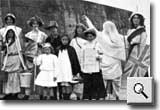 |
Party Time |
|
| |
People
in fancy dress in 1915. The tide is well out allowing
the people, a mixed group of all ages, to parade their
fancy costumes on the beach.
The Pier, constructed at the end of the 19th Century,
is clearly visible behind them. The sand, upon which
the people are standing, has now completely covered
the rocks which used to be very much in evidence before
the construction of the Pier.
|
| |
|
|
|
 |
|
| ....copyright
collieston's century 2003 |
|